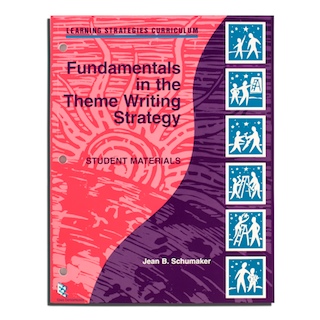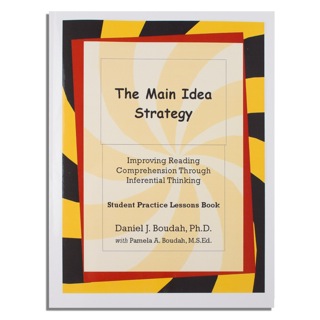Description
Research on the Theme Writing Strategy
Study 1
Overview
This study focused on the instruction of four writing strategies within a resource room program by the regularly assigned special education teacher. The writing strategies were taught across the course of a full school year. General education English and social studies teachers were recruited to give writing assignments in their classes to provide measures of generalization. Seven participating high school students with LD who had not been enrolled in general education courses in the past were enrolled in these English and social studies classes at the beginning of the school year. The students were first taught the Sentence Writing Strategy (Schumaker & Sheldon, 1985). Next, the students learned the Paragraph Writing Strategy (Schumaker & Lyerla, 1991). Subsequently, they learned how to detect and correct errors in their writing by learning the Error Monitoring Strategy (Schumaker, Nolan, & Deshler, 1985). Finally, they learned the Theme Writing Strategy (Schumaker, 2003). Throughout the instruction, the students’ writing performance in both the resource room and in the targeted general education classes was monitored. That is, every time they wrote a paragraph or an essay in any of the targeted settings, the product was scored for the types of sentences used, the organization of the paragraph, the number of errors, and the organization of the essay. A multiple-probe across-strategies design was employed.
Results
The seven students earned an average of 24% of the points available for a well-planned and organized theme during baseline and an average of 74% of the points after instruction in the resource room and in general education classes. The multiple-baseline across-strategies design demonstrated that each student made gains on pertinent measures only after instruction began for each strategy.
Five of the students made the same kinds of gains on their writing assignments in general education classes as they did in the resource room, even though they had not been taught to use the writing strategies in those settings. The two students who did not generalize their use of the strategies to other classes did so quickly after they had been taught to do so.
Before the study, the students’ GPA was 2.1 in special English and social studies courses designed for low-achieving students and students with disabilities; after the study, their GPA was 2.7 in regular-track general education English and social studies courses.
On a standardized test of writing instruction, the Woodcock Johnson Psychoeducational Battery, the students’ mean grade equivalent score increased by two grade levels from 6.2 to 8.2. On the district’s minimal competency writing exam, the students earned a mean overall score of 3.5 (out of 5.0), which compared favorably to the mean overall district average of 2.5. With regard to maintenance of strategy usage, the four students who returned to the school the following school year and who had learned all the strategies demonstrated that they could write organized themes in their general education classes at mastery levels.
Conclusions
Thus, this study demonstrated that high school students with LD could learn the Theme Writing Strategy in a resource room program when instructed by their regularly assigned special education teacher. It also showed that they could generalize their use of the Theme Writing Strategy to assignments given in their required general education courses and that they could maintain their use of the strategy across several months. It also showed that strategy instruction was associated with growth in standardized writing test scores and produced favorable writing competency test scores.
References
Schmidt, J. L. (1983). The effects of four generalization conditions on learning disabled adolescents’ written language performance in the regular classroom. Unpublished doctoral dissertation. University of Kansas, Lawrence.
Schmidt, J. L., Deshler, D. D., Schumaker, J. B., & Alley, G. R. (1989). Effects of generalization instruction on the written language performance of adolescents with learning disabilities in the mainstream classroom. Reading, Writing, and Learning Disabilities, 4(4), 291-309.
Study 2
Overview
This study investigated the effects of Theme Writing Strategy instruction on the writing performance of college students. The Theme Writing Strategy was taught by a former special education teacher to 28 freshman scholarship athletes enrolled in English 101, a required English course at a Midwestern university. Two of the students had learning disabilities, and one had ADHD. This group of students had earned an average score of 17.7 on the American College Test (ACT), a college-entrance exam, and a mean grade-point average of 2.8 in high school. Because of their academic deficits, these students were required to participate in academic tutoring for 6 to 10 hours per week because they were considered to be “under-prepared” for college.
Also participating in the study were 28 freshman scholarship athletes who had earned an average score of 23.2 on the ACT and a grade-point average of 3.3 in high school; they served as the comparison group. They did not receive instruction in the strategy, but they had free access to tutors for help with their assignments and also were enrolled in English 101. All students enrolled in English 101 were required to write six themes: three written out of class and three written in class. Their semester grade was based on their grades on the six themes. The themes were graded by their regularly assigned English professors.
Results
The results at the end of the semester showed that the experimental (underprepared) students earned scores that were significantly higher than those of the comparison students on a test of theme writing knowledge (even though their pretest scores were significantly lower than those of comparison students). Also, the experimental students earned an average grade of 2.5 (A = 4, B = 3, C = 2, D = 1, F = 0), and the comparison students earned an average grade of 2.6 in the English 101 course. For their first semester in college, the overall grade-point average was 2.5 for the experimental group and 2.54 for the comparison group. No significant differences were found between the two groups’ grades in the English 101 course and between their overall grade-point averages. With regard to the students with disabilities in the experimental group, all three earned Cs in the English 101 course, and they earned overall GPAs of 2.50, 2.62, and 2.91 during their first semester of college.
Conclusions
Instruction in the Theme Writing Strategy enabled underprepared college students to perform comparably to their prepared peers in an English 101 course. In addition, the two groups’ overall grade-point averages were comparable. Both groups had unlimited access to tutoring; the only difference was the instruction the experimental group had in the Theme Writing Strategy.
References
Hock, M. (1998). The effectiveness of an instructional tutoring model and tutor training on the academic performance of underprepared college student athletes.Unpublished doctoral dissertation, University of Kansas, Lawrence.
About the Author

Jean B. Schumaker, Ph.D.
Affliations
President
Edge Enterprises, Inc.
Lawrence, KS
Retired Associate Director and Senior Research Scientist
Certified SIM Professional Development Specialist
University of Kansas Center for Research on Learning
Lawrence, KS
Professor Emeritus
Department of Special Education
University of Kansas
Lawrence, KS
My Background and Interests
I grew up with a concern for children who need special help. One of my earliest experiences was organizing birthday parties for children with disabilities at the Matheny Medical and Educational Center in New Jersey. After the birthday parties were over and all the decorations had been cleaned up, I spent additional time with those children, putting them to bed, reading to and talking with them, and singing to them. Through those experiences and others as a camp counselor, I found that I loved being with children and teaching them. Eventually, I decided that I wanted to be a clinical psychologist, and I went to college and graduate school with that goal in mind. However, along the way, I got hooked on doing research! In particular, I got hooked on research related to ensuring that children learn. I’ve worked with children in schools, group homes, camps, hospitals, and clinical settings. Across all those experiences, I’ve learned that all children can learn. I’ve learned that, if we hold high expectations for them and use special teaching methods, they usually meet those expectations. I continue to do research with the goal of helping teachers teach and students learn.
The Story Behind the Theme Writing Strategy Program
I started developing instructional programs for writing skills in the 1970s when I was a graduate student at the University of Kansas. My graduate program required me to complete an internship at the probation department of the Douglas County Juvenile Court in Kansas. I was assigned several cases of truant secondary students. In working with these students, I learned that they could not write. They told me that one of the reasons they avoided school was that they were embarrassed because they could not complete the work assigned to them. I also learned that there were no instructional programs available to teach them writing in an intensive way. I embarked on a journey of developing writing programs that continues to this day.
The Theme Writing Strategy instruction is founded on principles that were taught to me by my high school English teacher, Mr. Brasher, from whom I was lucky to learn during all four years of high school. He created a diagram that we were to fill out before we began writing our themes. He also coached us in how to think as we were creating our diagrams and how we were to use transition sentences to provide the glue for our writing. He assigned 15-page papers when we were freshmen and never backed off on his expectations, despite many complaints from students and parents. Many of the complaints centered on the notion that students needed more prerequisite instruction before they should be required to write 15-page papers. Thus, Mr. Brasher’s ideas have been used as a foundation in the Fundamentals in the Theme Writing Strategy program to provide students with the fundamental skills they need to write themes and essays comprised of five or six paragraphs. The TOWER Diagram is a very simplified version of Mr. Brasher’s diagram, and the program involves intensive instruction in key types of sentences that form the glue within a theme. This program was designed to follow instruction in the Paragraph Writing Strategy, and the vocabulary used throughout this program is coordinated with the foundational vocabulary and instruction in the Paragraph Writing Strategy program and the Sentence Writing Strategy programs. The materials that students use to learn the skills are specially sequenced such that students start by learning easy skills and gradually work toward learning more difficult skills.
My Thoughts about Strategic Instruction
Strategic instruction is one of the few instructional methods that have been shown to be effective through empirical research to produce improvement in the learning and academic performance of at-risk students. The studies conducted on the instructional program for the Theme Writing Strategy have shown that students can learn to write well-organized themes and can generalize their use of theme-writing skills to their coursework and testing situations when this program is used with fidelity. Instruction in the Theme Writing Strategy has been included in scope and sequence plans at the middle-school and high-school levels in numerous districts across the nation. The strategy has been taught in general education and special education settings to a wide variety of students.
Teacher and Student Feedback on the Theme Writing Strategy Program
Teachers often report that the TOWER Diagram is a revelation for students, and they become less afraid to write a theme. The patterns set up for the introductory and concluding paragraphs are like security blankets for students, and their confidence in their writing builds during the Theme Writing Strategy instruction. Once their fears are allayed, students become more and more willing to write and more pleased with their writing.
My Contact Information
Please contact me through Edge Enterprises, Inc.
(jschumaker@edgeenterprisesinc.com or 877-767-1487).







